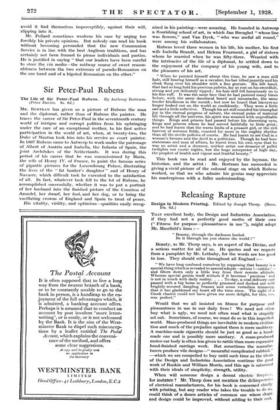Sir Peter-Paul Rubens
The Life of Sir Peter-Paul Rubens. By Anthony Bertram. (Peter Davies. 8s. 6d.) The Life of Sir Peter-Paul Rubens. By Anthony Bertram. (Peter Davies. 8s. 6d.) MR. BERTRAM has given us a picture of Rubens the man and the diplomat, rather than of Rubens the painter. He traces the career of Sir Peter-Paul in the seventeenth century world of intrigue and corrupt politics from his upbringing under the care of an exceptional mother, to his first active participation in the world of art, when, at twenty-two, the Duke of Mantua took him into his service as court painter. In 1607 Rubens came to Antwerp to work under the patronage of Albert of Austria and Isabella, the Infanta of Spain, the joint Archdukes of the Netherlands. It was during this period of his career that he was commissioned by Maria, the wife of Henry IV. of France, to paint the famous series of gigantic pictures for the Luxembourg Palace, illustrating the lives of the " fat banker's daughter " and of Henry of Navarre, which difficult task he executed to the satisfaction of all. In fact, whatever task fell to the lot of Rubens, he accomplished successfully, whether it was to put a portrait of her husband into the finished picture of the Countess of Arundel, her dwarf, her fool, and her dog, or to bring the vacillating crowns of England and Spain to treat of peace.
His vitality, virility, and optimism—qualities easily recog-
nized in his painting—were amazing. He founded in Antwerp a flourishing school of art, in which Jan Breughel " whose line was flowers," and Van Dyck, " who was useful all round," were among his collaborators.
Rubens loved three women in his life, his mother, his first wife Isabella Brandt, and Helena Fourment, a girl of sixteen whom he married when he was fifty-three. Wearied with the intricacies of the life of a diplomat, he settled down to the enjoyment of the company of his young wife, and to the pleasures of his art.
" When he painted himself about this time, he saw a man still hale, still bearing himself as a cavalier, his hat tilted jauntily and his cloak flung over his shoulder with a fine gesture. His left hand, that had so long held his precious palette, lay at rest on his swordhilt, strong and yet delicately tipped ; his hair still fell luxuriously on to his fine ruff. It was the same face that he had painted many times before, with the same dandiacal beard and moustache, the same tender kindliness in the mouth ; but now he found that his eyes no longer looked out on the world so confidently. They were a little sad and a little reflective. Though his art still sounded his triumphal joy in the eternal progress of nature, the eternal pulse of material life through all the universe, his spirit was wearied with unprofitable things. Kings and princes had passed before his discerning eyes, kings and princes whom he had served faithfully to little good ; and he had learnt that the warm limbs of a peasant girl, or the rich harvest of autumn fields, counted for more in the mighty rhythm than all the sterile policies of courts. He had learnt to see God in a woman's breasts and the devil in a politician. Though he had been statesman and man of affairs, he learnt from his own eyes that he was an artist and a dreamer, neither artist nor dreamer of pallid twilights nor exotic nights, but the huge interpreter of high day, the prophet of health and vigour and fruitful beauty."
This book can be read and enjoyed by the layman, the historian, and the artist : Mr. Bertram has succeeded in giving a vivid picture of the colossal stage on which Rubens worked, so that we who admire his genius may appreciate his masterpieces with a fuller understanding.






























 Previous page
Previous page